Replaces
2002 GMC Sierra 1500 with Rear Disc Brakes with Single Piston Rear Calipers without 4 Wheel Steering Rear Ceramic Brake Pad & Rotor Kit with Parking Shoes DIY Solutions BFS05463
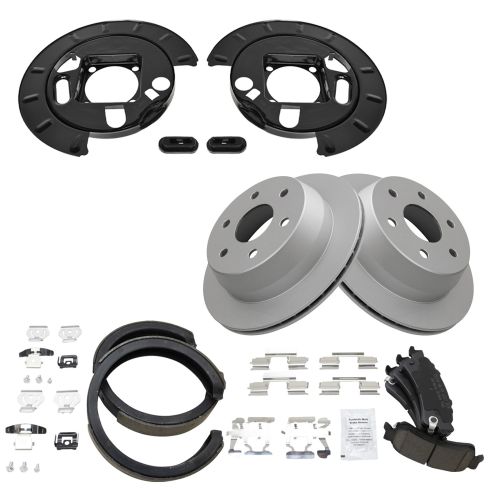

BFS05463
In Stock
This part doesn’t fit a . Select from parts that fit.
Specify your vehicle's year, make and model to guarantee fit.
Orders must be placed by 2pm ET
You may also like
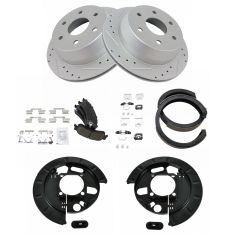
Ceramic Performance Brake Pad & Rotor Kit
$198.95
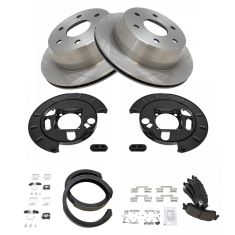
Ceramic Brake Pad & Rotor Kit with Parking Shoes
$199.95
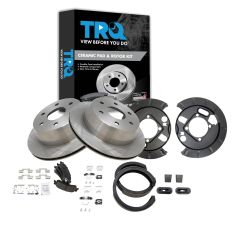
Ceramic Brake Pad & Rotor Kit with Parking Shoes
$201.95
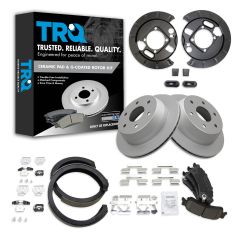
Ceramic Brake Pad & Rotor Kit with Parking Shoes
$201.95
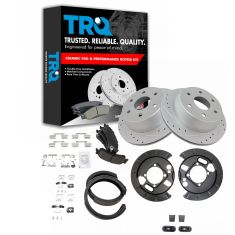
Ceramic Performance Brake Pad & Rotor Kit
$217.95
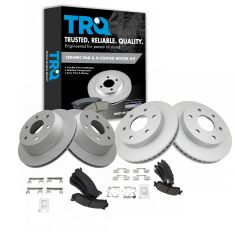
Ceramic Brake Pad & Rotor Kit
$259.95
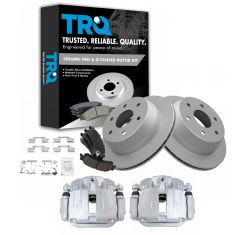
Ceramic Brake Pad & Rotor Kit with Calipers
$269.95
Part Details
- Brake Pad Bonding Type: Premium Posi
- Wheel Lug Count: 6 Lug
- Rear Brake Rotor Venting Type: Vented
- Brake Pad Friction Material: Ceramic
- Brake Rotor Coating: Premium G-Coated
- Rear Brake Rotor Diameter: 12.80 in. (325mm)
-
Kit Includes:
(1) Rear Parking Brake Shoe Set
(2) Rear Brake Rotor Backing Plates
(1) Rear Ceramic Brake Pad Set with Contact Point Grease & Hardware
(2) Rear G-Coated Brake Rotors
Specification
- without 4 Wheel Steering
- with Rear Disc Brakes
- with Single Piston Rear Calipers
- Rear
Complete Repair in One Purchase - Stop searching for parts individually and complete your repair with a customized kit or set from DIY Solutions.
High-Quality Parts from Trusted Brands - DIY Solutions' kits and sets are selected from the best automotive brands and include hard-to-find and even obsolete parts you may need for your vehicle.
Guaranteed Fit - DIY Solutions ensures its selected parts are quality-tested to guarantee fit and function.
Item Condition:
New
Attention California Customers:
![]() WARNING: This product can expose you to chemicals including Lead and Lead Compounds, which are known to the State of California to cause cancer, and birth defects or other reproductive harm. For more information, go to www.P65Warnings.ca.gov.
WARNING: This product can expose you to chemicals including Lead and Lead Compounds, which are known to the State of California to cause cancer, and birth defects or other reproductive harm. For more information, go to www.P65Warnings.ca.gov.
Lifetime Warranty
This item is backed by our limited lifetime warranty. In the event that this item should fail due to manufacturing defects during intended use, we will replace the part free of charge. This warranty covers the cost of the part only.










Created on:
Tools used
Tools used
You can take the center cap off. Use a straight blade screwdriver. Take that off. Use a 22-millimeter socket to take off the lug nuts. Take the wheel off. Take these two caliper bolts out. I'm gonna use a 12-millimeter socket and then a 16-millimeter wrench, just to hold the slide from spinning, loosen these up. Now we'll just use a screwdriver, pry the caliper off. Pull that out, then you can use a caliper hanger and just support it from the upper control arm right there. Just make sure there's no tension on the hose. Slide it over here. Take the brake pads off. Use the same straight blade screwdriver.
And take an 18-millimeter socket, take these 2 caliper bracket bolts out. Take these bolts out and slide the bracket right off. Now take the rotor off. If it's stuck on there, just take a hammer. Get a tap in these areas. Just try to not hit the studs. It should be loose. Try not to breathe any of that in, and slide it off.
We're gonna take the parking brake shoe off. There's a clip right here that's held in with an 8-millimeter bolt. Use an 8-millimeter socket to take that off. Slide that bolt out. Then we can slide this out. And if you just push the whole shoe assembly down, and get it to pop off, that lever right there, and this takes a little bit of effort. You don't have to take the axle out to get these off. Slide one side, get the other side out. Just like that. I'm just gonna take this adjuster out. Take that out. Clean that up a little bit. You can use a wire brush, and same with the other side. There should be a pin on that side. I'm just gonna put some grease on here before I put it back. Put the adjuster side on this side, and when you do the other side, it's going to be the opposite. And this pin's all cleaned up. Just put some grease inside there and get that pin in. Put a lot more grease on that. And the grease will hold it in there, and just slide this on this side.
Take the new shoes, and just angle this. This might take a couple tries to get it right. Here you go. Like I said, you really don't have to bend it, just angle it at the right angle. It might take a little practice. What you can do is get this to slide on like that and then we can move these afterwards. Just get it in the right position. You can try using a screwdriver or even some pliers. Try twisting this a little bit. Get that to line up with the screwdriver. Do the same on the other side. Find the correct hole down that matches the one you took off. Slide that in position with the new bolt and snug that bolt up, not too tight. That's good.
I'm just gonna clean up this surface right here. You can use a wire brush or some type of grinding wheel. Just be careful. You don't want to take too much material off, just get some of the rough stuff. Take a little anti-seize, put it on the hub area right here. When you go to put the rotor on, you may have to adjust the parking brake. You can spin that wheel either forward or backward and it will either tighten it or loosen it. Slide the rotor on, just make sure it spins good, and then double check with your parking brake, and adjust accordingly.
Slide the brake caliper bracket in place. Put the bolts in. You can use a little thread locking compound on the bolts. Now I'm going to torque these bolts to 122 foot pounds. I'm gonna install the brake pads. Make sure you have the brake pad warning indicator facing up on the outside and also on the inside. Now we'll take the brake caliper off. Take the hanger off. I have to compress the caliper so I use a brake caliper compressant tool. Just compress it really slow. This is gonna push the fluid through the hoses, back through the lines, back up to the master cylinder and into the reservoir. Just go nice and slow.
That's compressed. Pull the compressing tool out. Slide the caliper over the brake pads and the bracket. Take the two bolts. Install the bolts. You can put some thread locking compound on those bolts. I can use my 16-millimeter wrench, 12-millimeter socket, torque these bolts to 31 foot pounds.
And reinstall the wheel. Put the lug nuts on. Now I'm gonna torque these lug nuts to 140 foot pounds in a star pattern to tighten the wheel down evenly. And just go around again, double check.
And reinstall the center cap. Now we're gonna pump the brake pedal nice and slow. There's gonna be an air gap between the caliper piston and the brake pad, so we want to eliminate that air gap. Once the pedal feels good, then you're all set. Check the brake fluid level in the master cylinder reservoir. There's the minimum line right there, the max line right there. Adjust accordingly.
Tools used
Okay, friends, one of the first things we have to do is safely raise and support the vehicle. Once you have your wheels off the ground in the rear, we're gonna go ahead and remove all six of these lug nuts. Remove your wheel. Now, that the wheel is off, we have a clear view of our caliper. If you were to be able to see behind this tin, you're gonna be able to see where the caliper piston is. We need to be able to push that piston back.
To do that, if this shield wasn't here, you can come in between and just slowly pry, or if you do have that shield where you can come is right up along here, just get in between the pad and the caliper, and then slowly pry as well, and just keep working your way back and forth until the piston is all the way in.
The next thing that we need to do is remove our caliper bolts. These are the bolts that are gonna hold the caliper to the bracket. I like to hold onto my slider, so it can't spin. I'll leave that bolt loose, but leave it in for now. Do the same to the other one. I can get both these bolts outta here. Hold onto that caliper so it can't fall. Slide it off. I always like to take a peak at my caliper to make sure that it's not leaking any fluid along where the boot should be. Set this aside. Now, let's remove those brake pads. Set those aside.
Now, we have a clear view of our brake caliper mounting bolts. Remove them both. And then put in a couple threads. Remove the bracket. At this point, you wanna give your rotor a little wiggle. If it doesn't seem like it wants to break free, grab a lug nut, start it on there a few threads. Now, with your hand protection and eye protection, of course, we're gonna go ahead and give it a bonk with a hammer to break it free. You can come right up along the top here.
If that doesn't work and you're not reusing your rotor, of course, you could, of course, bonk on the braking surface, or even better than that, from the backside. Remove your rotor. Now, it's gonna be time to prep the brand new rotor. To do that, you wanna make sure you clean the braking surface. A little bit of parts cleaner, a nice rag. Get off any of the coding that might be on there. It should come with a little coding on there to prevent against rust. Go ahead and flip that over.
Now, you can see the other braking surface. We'll clean that. And now, we also wanna make sure we clean this area right along here, because this is where the emergency brake shoe is gonna ride. Now, at this point, you have a clear view of your e-brake shoe and of course of the axle mating surface where it's gonna connect onto the rotor. If you're axle looks as though it's in poor condition, maybe it's got a lot of rust, or rot, or debris, or anything like that all over it, you'd, of course, wanna sand it down, make it look nice and smooth, and then code it just like this with some copper Never-seez.
Before we go ahead and put the rotor on there, we also wanna take a look at this right here. This is your emergency brake shoe. If you happen to notice that your emergency brake shoe doesn't have any meat on it, maybe it looks a little bit more like this one where it's literally just a solid shoe of metal and it has no more breaking material, you need to go ahead and replace that. And if you need instructional video on how to do that, we have it. We get a nice new coding of Never-seez on there after we cleaned it down. We've got our rotor. Carefully, slide it up on here. We get the rotor on there.
Now, what we need to do is head up our vehicle in neutral, so that we can spin our rear wheels. And we just kinda wanna push in and give this a little spin, and listen for a scraping noise. I can hear a very minor scraping noise there. So that tells me that I don't have very much drag from my e-brake shoes to the inner portion of my rotor. If you put your rotor on, maybe it was a difficult time pushing on, and you went to turn it, and it just didn't want to turn at all, your e-brake shoes are probably over adjusted and you're gonna have an issue.
If that was the case, you would just pull this off and then you can look down here at your adjuster. With the caliper bracket over on the bench, I just wanna show you areas that you're gonna wanna clean up. You wanna clean up this area right along here, and right there, the same right here. If you were to take your tin and you were to put it over it, any area that touches that... If you were to take your tin and put it right over the bracket, you'll be able to see exactly where you need to clean up. Any areas that the bracket is gonna touch up against this tin need to be nice and smooth, and they also need to be lubricated. Just take your little brush, clean up in between there, clean up all this right here.
If there's any really tough areas that don't seem like they wanna break free but they're raised up, use a nice screwdriver or whatever you might have, and just kinda clean up any of that crud or anything like that that might be on there. Now, once you've cleaned all the mounting areas for where your tins are gonna go for your brake pads, you're gonna come right here to the sliders. Grab that, pull it right out. Take your rag, clean it up. Inspect the slider, make sure it's in good condition. If it looks like it's pitted or it's gonna cause restriction going in and out, you either need to clean it up better with a wire wheel or replace it.
If you were to look inside here, you're gonna need that to be nice and clean as well. You can do something as simple as maybe using a bore brush, something like that inside there. Of course, you don't wanna damage the boot, though, so you'd wanna be very careful. Get out as much of the crud as you can inside there, make it as clean as possible.
Maybe even take a nice rag, twist it, put it right inside there, and get out as much as possible. I'm gonna use some nice silicone here. This is Moly grease, it's great for calipers. You wanna make sure you get right up along this area right there. If you can see where that lip is, where my finger is, get some grease all up on there. It's gonna be super important because that's gonna help keep moisture out right along this seal.
Slide that in there. Give it a nice twist. Move along. Those sliders are in there. Let's go ahead and go right along the bracket. Just go right in this area. As you can see, I have it along all ridges going along. Now, I would put my tin on here. See if I can get this lined up. Slide it down. Do the same to the other side. Let's grab our caliper bracket and our caliper bracket bolts. If you have any leftover threadlocker on them, make sure you clean it off. And if you wanna put on some new, it's probably a great idea.
Put this right over. Start in both of your bolts before you tighten either of them down. Now, let's bottom them out and then we'll torque them to manufacturer specification. Let's go ahead and torque these to 148 foot-pounds. Now, it's time to install our brake pads. When you go to install it, you wanna make sure that you have your squealer or the wear indicator facing down. And so I got that one right here. Slide that in. And then my outer pad, I'm gonna do the same thing. My wear indicator facing down.
What I'm doing now is I'm lubricating the mating points where the pads gonna touch up against the caliper. So right along that piston, and then of course, both of these ears. Awesome. See if we can slide this over. Grab your bolts. If you want to use some threadlocker, once again, you're prerogative. Now, let's torque these to 31 foot-pounds. Hold that. There we are. So now, let's just go pump up the brakes.
Now, it's gonna be time to get the wheel up on here. Let's start on those lug nuts. And then we'll bottom them out. And we'll torque them to 140 foot-pounds. Let's torque them. Double-check them if you want. And if you have a center cover, put that on as well. Let's make sure we double check that brake fluid. Give it a wiggle. It looks as though this is low. There's the maximum line. Open this up. We're gonna add some DOT 3 brake fluid. Bring it right up to that maximum line. Make sure you close it back up, down the road, you go.
Tools used
Tools used
Tools used
Tools used
I'm gonna start by taking the wheel off. I'm gonna use a 22-millimeter socket, take off all the lug nuts and take the wheel off. Now, we can take these caliper bolts out. I'm gonna use a 12-millimeter socket, loosen those up. And if the caliper slide is spinning, you can use a 17-millimeter wrench to hold it while you take the bolt out. Then you can grab the caliper. You might wanna rock it back and forth a little bit, that'll compress the piston a little. Make it easier to slide off. Then you can use a brake caliper hanger and just hang it from the upper control arm or you can hang it from the coil spring just like that. Just make sure there's not any tension on the brake hose itself. Now, take the brake pads off. Just slide them out of the way.
Now, we're gonna take the bracket off. you need to take these two bolts out. Use an 18-millimeter socket, loosen these up and then grab the bracket and just slide it off. Now, we're gonna take the rotor off. Just grab it and slide it. If it's stuck on there, you can take a hammer and just hit in these locations. It's stuck on the parking brake a little bit. Just try to wiggle. You can just take a pry bar, try to pry in here a little bit to get this off. I'm just gonna take two screwdrivers, just try to wiggle this back and forth. There we go. Slides right off. Now, I took all the breaks off for this side, I did the same on the other side. Now, to access the cover, I'm gonna pull this bar out of the way. I'm gonna use a 13/16 wrench or a 21-millimeter wrench. On the backside, there's a nut on the other side of this bolt, and take that bolt out. Use a 21-millimeter socket. I'm just gonna use a bungee cord and just pull this out of the way.
Now, it's always a good idea before you take the cover off to take the fill plug out. Otherwise, if you can't get the fill plug out, then you won't be able to add fluid to it after you're done. So, just use a 3/8 extension and a ratchet. There we go. Now, some of these cover bolts are pretty rusted, so I'm just gonna take a wire brush, just try to clean up some of the rust. All right. Now, I'm gonna take the cover off. I'm gonna use a 13-millimeter socket, take all these bolts off. Now, I'm gonna leave the top one in a little bit. Just leave it loose and then I'll pry the cover off. This one has the brake bracket right here, brake hose bracket or brake lines. Move it out of the way. Just be careful. If this looks really rusty, be more careful with it. I'll just loosen this one up. I'll just leave it like that. Make sure you have a drain bucket underneath before you start taking those bolts out. And then just get a screwdriver or a pry bar, just get underneath the cover and just slowly pull it back. Let the fluid drain.
And once that's loose, you can take the bolt off and just slide the cover up. There you go. You need to put the transmission in neutral and rotate the driveshaft so that this bolt ends up right here because we're gonna take that pin off. Now, we're gonna take this bolt out, which actually has a pin that goes through there, and I'm gonna use an 8-millimeter socket. You can try to use a wrench. Sometimes it's not so easy. And just take that off, loosen that up. I'm gonna slide this out. You're gonna have to go around the carrier and then try to push on the pin and slide this out. Now, I'm gonna carefully rotate the driveshaft again. Just make sure the gears aren't turning because you don't want them to fall out. That looks okay. Now, I need to hit the axle. Use a rubber mallet or a dead blow. Just tap it in. What you're looking for is there's a clip in there, and you need to be able to access that clip. Right now I can't get to it, so we're gonna tap this in more.
All right. So, now the C-clip is out far enough that I should be able to grab it with a magnet. Just use a magnet and grab it. You might have to rotate it a little bit. Slide it out like that. Now, I can use a pry bar and just pry the axle out. Be careful. Just pry right where the parking brake mechanism is right there. Once you pry out that far, then it should be easier to pull it out. There is a reluctor wheel in there that it presses on to and it just drops down once you pull that out. Slide the axle out. So, when you're replacing the dust shields, it's always a good idea to replace the seal, the axle seal, especially when you take it out, put it back in, otherwise, you may cause a leak. Now, I'm gonna take this parking brake shoe off. You're gonna take these adapters off and take these two little bolts out. Use an 8-millimeter socket. Take these hold-downs off. Take those off. We can grab the parking brake shoe and just slide it out, then slide it off.
Now, I need to take this bracket off right here. There's a little pin in here, so just make sure you take that off. This is what activates the parking brake, and the adjuster side, take that off just so you don't lose them. I'm gonna use an 18-millimeter socket, take these bolts out. All right. Now, you wanna take this whole assembly off. If it doesn't come off, just take a hammer, give it a tap from the backside and slide it down. Now, we're gonna take this part of the cable off. There's a lever right here, you just have to pull it out a little bit just like that. Then we can pull the spring down. And then there should be two teeth on the end of this, it shouldn't come off that easy. If you take some pliers, there should be two teeth right here that you got to squeeze. You just use some pliers. All right. Now, just take this shield off the bracket. Just use a straight blade screwdriver. And there's two tabs, so you wanna pry right here and here. And you should be able to slide this out just like that. Then there's that rubber grommet right there. So, you get a new one. Just try to put it on the same way the old one came off. And if this is excessively rusty, you can use a wire brush to take some of the rust off. This one is not too bad. Just line this up just like that. Make sure the grommet looks good. You can fold these tabs over a little bit. It's hard to fold them over with this on the ground. You can use a screwdriver just like that. There we go.
Now, I'll just pull back on the spring a little bit, slide the cable through. It should lock in place. And then take this mechanism, the lever, slide it through the rubber grommet and it's got to sit in there Like that. So, that's almost flat up against the shield. Now, I'm just gonna use a wire brush just to clean some of this up. Great. Looks good. Now, you can take the shield and bracket. And there is an arrow pointing to the front of the car. And the other bracket on the opposite side has the same arrow, but it's upside down on the other side. I'm gonna take the bolts, get the bolts started. Now, I'm gonna torque these bolts to 100 foot-pounds. Then if these tabs if you didn't bang them down far enough, just take a chisel or a punch and just tap them down a little more so they don't rub. Looks good. Then you can take this adjuster for the parking brake, slide that in. I'm just gonna use a little bit of brake grease on this side and put a little brake grease on the pin as well. Slide that one in.
All right. So, that looks pretty good. If this doesn't seem like it's all the way down, you can grab the arm on the backside and try to wiggle that to try to get that to work right. And if you have new parking brake shoes, now is a good time to put them on. If not, just reuse your old ones. And just slide this on the adjuster. It is slotted, and you can rotate it up and then put the brackets on and the bolts and the other bracket. Then snug those bolts up and slide the axle in. And then you're gonna have to tip it up a little bit just to get it. And you don't wanna twist it too much because then you're gonna mess up the spider gears. And I'm gonna have to give it a couple more taps so that I can get the C-clip in. Looks good. And just take the clip, slide it in position. Once it's all the way in, then just slide the axle up. Then you can do the same procedure on the other side. And after you've done that, then let's rotate the axle...rotate the driveshaft, I mean, and get the pin lined up. And you may have to move the bearings a little bit. I mean the spider gears. Just make sure the hole is lined up with where the bolts goes. There we go. You can give it a little tap with something soft and slide the pin back in, the pin bolt and tighten that up.
Now, I'm gonna torque this bolt to 27 foot-pounds. This vehicle has 8.6 rear end. If you have a 9.5 rear end, you're gonna torque that to 37 foot-pounds. At this point, you can put the vehicle back in park. At this point, I can use a scraper or even a razor blade. Just be careful if you're using a razor blade, and just scrape off any excess gasket material. Now, I'm gonna use a little brake parts cleaner and just wipe this down. Just try not to spray directly into the gear. Now, I can take the gasket and just line that in position. Then take the cover. Try to go over the gear. There you go. Just twist it a little bit. You don't have to take the sway bar links out, but you could if you're struggling with that and just line this all up and get the bolts started. And now I can move this brake hose bracket down and brake lines and get that bolt through. I'm just gonna snug these down before I torque them down. Now, I'm gonna torque this to 30 foot-pounds. And make sure you torque it in a cross pattern. So, we'll torque this one and then just go crisscross. All right. That's all in. If you're not gonna use this fill plug to fill up the rear differential, you can use a 10-millimeter hex socket and tighten that up. Just make sure it's snug.
Now, just hook this up and torque this to 77 foot-pounds. With the fill plug out, I'm going to add the limited slip additive first. It's always a good idea to add it and do that first before you add the gear oil. Then add the proper gear oil. You can check your owner's manual. You can use a hose to get the fluid into the rear diff. All right. Now, as you're filling this up, if you notice that it starts coming out the fill plug, then that's up to the ideal level. Certain vehicles, it doesn't have to go all the way to the fill plug, you wanna check your owner's manual and put the appropriate amount of fluid in. Now, put the fill plug in and snug this up not too tight. Once it starts getting a little snugger, just a little bit more. Looks good. Take a little break parts cleaner and clean it off.
Now, take the caliper bracket and line it back up. Brake caliper bolts, get those started. Now, I'm gonna torque these bolts to 122 foot-pounds. Now, I'm gonna put the brake pads on. Now, the warning indicators are gonna go to the top. So, on the inboard pad goes at the top and same with the outboard pad. Just slide them in position. That's good. Now, we're gonna take the brake caliper off the hook and just slide it over the brake pads. Put the caliper bolts in. Take a 17-millimeter wrench and torque this bolt to 30 foot-pounds. Do the same on the top. All right. Put the wheel on. I'm gonna put the lug nuts on. Now, I'm gonna torque these lug nuts to 140 foot-pounds in a cross pattern so that it tightens the wheel down evenly. And just go around and double-check.
Tools used
Okay, friends. One of the first things we have to do is safely raise and support the vehicle. Once you have your wheels off the ground in the rear, we're gonna go ahead and remove all six of these lug nuts. Remove your wheel. One of the next things that we need to do is take a nice small pry bar like this, we're gonna come in between the caliper and the pad and we're just gonna apply a little bit of leverage. What we wanna do is just push in that caliper piston just a teeny bit to take the pressure off of the brakes. The next thing we need to do is remove our two 18-millimeter mounting bolts for our caliper. Just take a wrench, can use a socket with a ratchet if you'd like. There's one bolt. I'm just gonna start that in just a couple threads to hold the caliper for me while I remove the second. There it is. Let's get that other one out of there. Next, we're gonna take the caliper and we'll just set it up here where it's gonna be nice and safe. Just make sure you put it somewhere that it's not gonna potentially fall down and hopefully not hurt you in any way.
Now it's gonna be time to remove your rotor. You might need to give it a couple light bonks. The next thing we're gonna do is use our 8-millimeter and we're gonna remove this small bolt right here. Just be careful because very often it's frozen in there and it might break off. Nice long ratchet did the trick. That little bolt out of there. Grab this out of here. Set those aside. Just gonna grab onto this. You'll notice it can move around now. If you were to look under here, you're gonna see the adjuster. If you just take that shoe, move it kinda closer to the axle and then give it a loving bonk down, it should come free from the adjuster. Go ahead and grab that shoe. At this point you can try to weasel it off the axle. There we are.
The next thing we're gonna have to do is take out this area right here. This is gonna be the adjuster and it should separate. We'll just spray it down with some penetrant. That looks good. Grab my little pry bar here. We need to separate the cogged area from the base area. Okay, starting to come up. Get this side out of there too. Right inside this area is where the adjustment's supposed to be for the emergency brake shoe. If you take it apart and you happen to notice that this part right here is frozen, the part that has a little cog, this part right here should spin in there. If it does not, you need to completely separate these, clean them up, re-lubricate them and then, of course, put them back together. This piece right here has like a little bobble. Believe it or not that's not one piece. It actually does come apart so you wanna be careful not to lose this. It's a great idea to clean all this up as well. That's just about good right there. This flows smoothly. It's looking great. You wanna make sure that this area right here is nice and clean, free of debris or anything that might obstruct it from being able to spin because that's gonna go inside this hole right here. How can I tell that this goes inside of this hole and not in the bottom hole? Because of this little clip right here. That clip is gonna line up with the notches on this and it's gonna prevent it from spinning on its own. We're not gonna put that in yet though. What we're gonna do, grab some more of that caliper grease and we're gonna put it right inside the hole on the other piece. All right, this is gonna be the other end. Just try to fill it right in there if you want. Get some more. More the merrier. Put it right in. Now I'm gonna grab my nice, clean pin. I inspected it. It's in good condition. I'll just put it right in there. Now we need to put a nice coating of that grease all along the areas where it's gonna rub up along the unit right there.
Now that those are nice and coated, let's continue on with the grease a little bit more and we're gonna go directly to where the adjuster is gonna be. You can go ahead and put in as much grease as you want. If you put in too much, it's not really that big of a deal but what you will notice is it will kinda come out and if that was to happen, you would just kinda clean it up so you don't get any mess on your emergency brake shoe. Now we're gonna take our pieces. Should slide right in there. Make sure it spins like it should. Do the same to the other side. You're gonna need a little bit more of that caliper grease or whatever type of grease you're using and you're gonna put it on the contact points of this bracket where the emergency brake shoe is gonna ride. The reason for that is of course for vibration dampening and noise reduction. So, we'll come right down here because we know it's gonna ride right along the outside there. Right here. This is a spot right there. If you were to come up here, you're gonna have this whole area. It hits up against there. And then if you come along the other side, you can clearly see exactly where the emergency brake shoe was riding before.
There we go. Now it's time to get the emergency brake shoe back up on here. To do this, you're gonna have to do a little bit of contortioning and just a little bit of wiggling and I'm sure over a period of time you should be able to figure out how to get it right over there. There we are. Nice light bonk. No big deal. We'll go ahead and line these tabs up with where it's supposed to sit on the adjuster there. Should slide over. If it doesn't, you can just kinda go past. Line up the adjuster ends so they're straight up and down so they'll line up with the way that the shoe needs to go on. Once you've gone past, like I said right here, you should be able to just kinda stretch it and draw it straight up on there. That looks great.
Now it's gonna be time to get the mounting bracket on there. It's a kind of funny looking thing, but if you were to look at it, you would see that it has an indented area right here. That's gonna ride right on this bracket right there. You want it to be kinda facing in this general direction so that the black part is gonna be riding up against the inner portion or the inner ridge of this shoe. Put it up on there. Line up your screw hole and then put in your screw. All right, so that's pretty much bottomed out right there. At that point, you definitely don't wanna go too much further because it is just a very small bolt, but something that I would like to mention is you also don't wanna go tight enough. With that said, once it's bottomed out, just give it a teeny bit more. Make sure it doesn't feel as though it's super loose to you. Give this a nice little wiggle. Make sure you don't see any movement between this and the bracket itself. I think that that looks great.
The next thing that we need to do is clean up the mating surface where the rotor is gonna match up against the axle. If it's all bumped up like this or rough in any way, just go ahead and sand it down with something. Now that the majority of the area is nice and clean and sanded down, we need to continue on by getting in between the lug studs and the rest of the hub area here, right in there. If you notice there's a large build up, you can use something like this, maybe a scraper or even a flathead screwdriver, just kinda get the majority of it up. Then you can take a nice brush, just work at the rest. Now we're gonna spray down the mating areas with some copper never seize.
Go ahead and put your rotor back on there. Look at the backside. This is the area that's gonna meet up against the axle. You need to make sure that's nice and clean as well. Now that we've cleaned up the backside of the rotor, we're just gonna place it over the axle like this. Push it all the way in and it should go over the emergency brake shoes. If it doesn't go over the emergency brake shoes, de-adjust your adjuster. If it does go over but you feel as though there's no drag at all, you're probably gonna wanna adjust it up a little bit. What you're actually gonna wanna do right now is get it so it's a semi-close so you can hear the shoes just barely dragging in there. Okay, that's the sound of the shoes hitting up against the inside drum portion of this rotor. If it's too tight and you try to turn it and it just doesn't wanna turn, then you know that it's over-adjusted. If your brakes are over-adjusted, they're gonna overheat and you're gonna have major braking issues.
Now it's gonna be time to get the caliper back on the vehicle. Before you go ahead and do that, you need to make sure that you clean all the existing thread locker off of these bolts, and I always like to replace it with some new thread locker of my own. Caliper around here. Make sure that your pads are situated inside the brackets as they need to be. They might keep wanting to fall out if they're like mine. Go ahead and grab those caliper mounting bolts. Start them both in. Now we'll snug them up and we'll torque them to 148 foot-pounds. We got our torque wrench. The next thing I always like to do at this point is to make sure I pump up the brake. Now it's gonna be time to get the wheel up on here. Let's start on those lug nuts and then we'll bottom them out and we'll torque them to 140 foot-pounds.
Let's the torque them. Double-check them if you want and if you have a center cover, put that on as well. Let's make sure we double-check that brake fluid. Give it a wiggle. It looks as though this is low. There's the maximum line. Open this up. We're gonna add some DOT 3 brake fluid. Bring it right up to that maximum line. Make sure you close it back up. Down the road you go.
Tools used
Tools used

BFS05463
In Stock
Product Reviews
877-844-3393
Monday - Friday 8:00am - 9:30pm ET
Saturday - Sunday 8:00am - 4:30pm ET
Specify your vehicle's year, make and model to guarantee fit.
This part doesn’t fit a . Select from parts that fit.


















